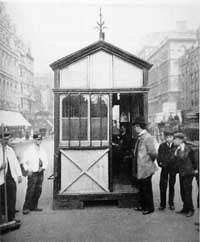|
Many Dial-a-Cab drivers avail themselves of those eating
establishments known as ‘green huts’ to passengers, but which we
rather more correctly refer to as Cab Shelters. Thanks to
Norman Beattie in
Winnipeg, Canada – quite probably the world taxi trade’s
foremost historian – this issue of Call Sign looks
at the origin of the Cab Shelter… "The cabmen's shelter (which figures prominently in Ulysses) was an institution designed to provide drivers with a place to get in out of the cold and have a cheap meal without straying from the cab stand. The first shelter was erected in London in 1875 at the instigation of Sir George Armstrong, a newspaper publisher who sent his servant out one blustery January day to fetch a cab from a nearby stand. The servant was a long time returning because the drivers had all abandoned their cabs and retired to the warmth and conviviality of a local pub. It occurred to Sir George that if the cabbies had been provided with a heated shelter on the cab stand, his |
History of the Cab Shelter… |
|
 An early Cabman’s Shelter situated almost opposite Harrods! |
evolved somewhat, but by the
1890s it had standardised as a small, green-painted shed with a
tiny kitchen at one end and bench seating for about a dozen
customers on either side of a long, narrow table top. The cost
for each shelter was about £200. The shelters were located on the cab ranks, either in the curb or middle lane of thoroughfares. Police regulations dictated that the size of the shelters could not exceed the space occupied by a horse and carriage. At their peak there were 61 cabmen's shelters in London, with many others scattered in cities and towns around England. Thirteen of the London shelters still survive as ‘listed buildings’ and all continue function as diners, each with its regular clientele of cab drivers." You can enter the amazing historical world of taxis with Norman Beattie at… http://tinyurl.com/af9wuz |
|
|
servant could have found a cab
much sooner. Sir George immediately started a building fund and
got some of his friends to contribute. Not coincidentally, the
first shelter was located on the closest cab stand to Sir
George's (Belgravia) home. The idea caught on and more shelters were built by the Cabmen's Shelter Fund, which equipped them with kitchens and recruited retired cabbies to operate them. The shelter design |
||
|
Warwicks help take taxis to China! |
|
 Patrick Plant with the new London Taxi company logo |
we are delighted with the end result. Early
feedback has shown how popular we think it will be." The logo is the latest in a long line of wide-ranging projects undertaken by Warwicks for LTI in a partnership spanning more than a decade. They had previously worked on manuals and handbooks for various LTI models including the TX4 and have designed international brochures, which have been reproduced in numerous languages. Patrick Plant, Managing Director of Warwicks, added; "The move into China is the dawn of a new exciting chapter for LTI and Coventry’s motoring heritage. As a fellow Coventry firm with roots in the city for four decades, we are pleased to play such a big part. LTI’s famous taxi is now clearly recognised as a British icon and we are proud to be involved in its first venture to the Orient." Since being formed 40 years ago, Warwicks has played an integral role in the brand building process for some of the biggest names in the motoring industry and enjoyed relationships with some of the top international brands such as Jaguar, Land Rover, Massey Ferguson, Dunlop Aerospace and Aston Martin. Many of these relationships have spanned more than a decade and some have lasted more than a quarter of a century. More than a design and marketing agency, Warwicks prides itself in identifying opportunities for clients and helping to deliver mutual and sustained growth. |
| Leading
design and marketing agency, Warwicks UK, is helping to
fly the flag for Britain on one of the country’s most iconic
symbols - more than 5,000 miles away in Beijing! The Coventry based company from Cheylesmore had been commissioned to design a new international logo for taxi manufacturers LTI Vehicles and the finished result will be displayed with pride on London Taxis built at their Shanghai joint venture with Geely Automotive. The logo is designed to promote The London Taxi Company - a new brand established together with Geely as part of their joint venture company. Together, the logo and name will be used as the new international sales brand. International Market Development Director at LTI Vehicles, Matthew Cheyne, told Call Sign: "We chose three main colours for the logo - red, white and blue - to symbolise the flags of both countries. With the basic design coming from within the company, the designers at Warwicks evolved our ideas and early sketches into the finished logo and |
|
|
|
Powered by NetXPosure |
| Copyright 1997-2009 Dial-A-Cab Ltd, All rights reserved. |